#Pammel Creek
Photo
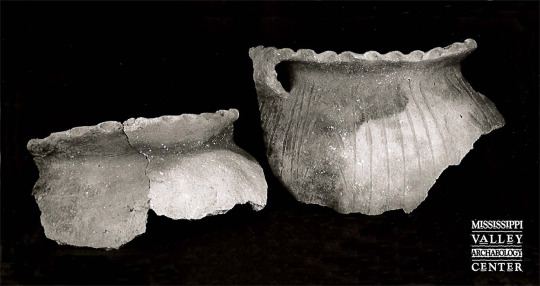
Excavations at the late precontact Oneota Pammel Creek site just south of La Crosse, Wisconsin, in the late 1980s revealed a large number of sherds and vessel portions that show evidence of burning after the pots broke. This is indicated by discontinuous charring on the edges of larger fragments. Some vessel portions also have smoked or partially smoked surfaces. Those with partially smoked surfaces include sherds with irregular, sharp boundaries between the blackened and unblackened areas. These patterns indicate that the unblackened areas were covered and thus protected from charring. The shapes of the unblackened patches suggest they were covered by another sherd.
It’s unclear why these sherds were burned before they were discarded in refuse pits, but from the large number, it seems to have been a common occurrence--and therefore, perhaps intentional. Similar sherds have been found at other local Oneota sites as well. One possible explanation is that the sherds were stacked over new vessels during the firing process to form a simple kiln.
18 notes
·
View notes
Photo


Few musical instruments have survived, although music was undoubtedly an important part of the lives of the area’s first inhabitants. This object was made from the wing bone of a goose and based on some experiments done with replica objects, was probably played by blowing gently across the top of the hole. You can see how this works by blowing gently over the top of a bottle, and seeing how the sound changes. (Oneota, Pammel Creek Site, La Crosse County, WI)
Link to 3D image: https://sketchfab.com/3d-models/bone-flute-oneota-culture-ad8ec9c1f7b240d38a6f5edf50497d47
3D scan courtesy Dr. David A. Anderson, Associate Professor, UWL, Dept, of Archaeology & Anthropology.
16 notes
·
View notes
Photo
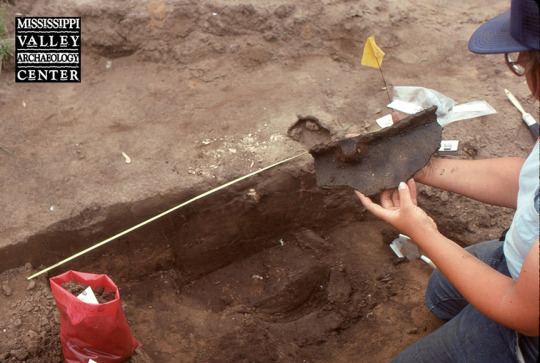
Connie Arzigian lifts an Oneota rim sherd with handle from a pit feature at the Pammel Creek site (47LC61) in May 1989. This site is the type site for the Pammel Creek phase (A.D. 1400–1500) in the local Oneota sequence. The bold finger impressions on the lip of the vessel are typical for pottery from this phase. The Pammel Creek site is located south of La Crosse, Wisconsin.
14 notes
·
View notes
Photo

Thanks to Jim Theler for this week’s post –
Bears and Wolves
This partial maxilla (upper jaw) of a bear and distal humerus (upper front leg) of a wolf were found at the edge of pit-type Feature 167 at the Pammel Creek site in La Crosse. The wolf humerus had cut marks at the distal end, probably from separating the humerus from the lower leg bones (radius and ulna). A fragment of a beaver skull was found as well. Pammel Creek is one of many late precontact “Oneota” village sites in and around La Crosse; it dates to about AD 1400-1500.
The American black bear (Ursus americanus) and the gray wolf (Canis lupus) are striking large mammals in the Upper Midwest. Black bear bones occur in small numbers at many Oneota habitation sites in western Wisconsin, most commonly as toe bones. This pattern might relate to foot bones being left on a bear’s skin (Martin 2020). Bear teeth, either isolated (loose) or still in the jaw bones, are less frequent at Oneota sites, but they do occur. They are also found at some Woodland sites. Wolf remains are very rare at all sites in our region.
Martin, Terrance J. (2020). Use of Black Bears in the Western Great Lakes Region and the Riddle of the Perforated Bear Mandibles. In Bears: Archaeological and Ethnohistorical Perspectives in Native Eastern North America, edited by Heather A. Lapham and Gregory A. Waselkov (editors), pp. 109–139. University of Florida Press, Gainesville.
17 notes
·
View notes
Photo

Thanks to Jim Theler for this week’s post –
The photo on the left shows a partial horn core of a bison just below the trowel in a refuse pit at Pammel Creek, an Oneota site in La Crosse County. Bison bones, other than shoulder blades (scapulae) made into hoes, are very rare at La Crosse Oneota sites. They include a few foot bones and at least two horn cores. The horns of bison might have been brought to the La Crosse area, probably from hunts to the west or through trading, along with the ever present bison scapulae. Native peoples of the historic era to the west of Wisconsin were adept at removing the outer horn from the horn core. The outer horn is made of a fibrous protein called keratin. The photo on the right shows the Pammel Creek horn core compared to a modern bison skull with the keratin sheath. Animals such as bison, cattle, and rhinoceros have horns supported by a horn core that are not shed during life. Early travelers in the west, such as the German Prince Maximilian, who spent time with the Mandan and Hidatsa on the upper Missouri River in the 1830s, made repeated reference to spoons made of bison horn. Modern bison horn spoons can be found with an internet search.
It should be pointed out that antlers are very different from "horns." Antlers are found on male members of the deer family, such as deer, elk, and moose. They are shed annually, and are not "horns." Thus, the reference to "elk horn" or "deer horn" is technically a misnomer.
8 notes
·
View notes
Photo
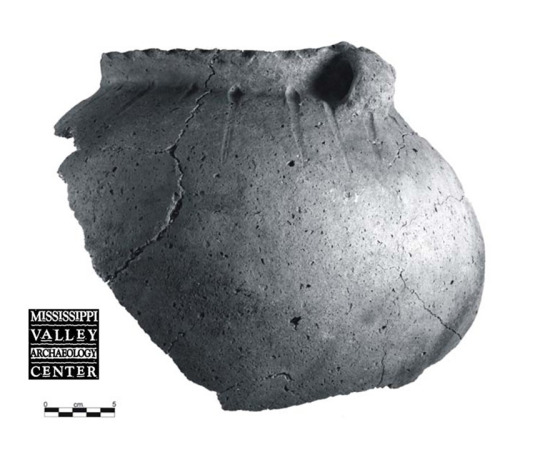
This large vessel section, called Vessel 108, was found in the early 2000s during excavations in the Sanford Archaeological District in La Crosse, Wisconsin. This late precontact Oneota site was inhabited during all three phases of the local Oneota occupation. Vessel designs and decorations provide clues to an Oneota vessel’s age. The rim of Vessel 108 has bold notching on the lip top to exterior lip, and the shoulder has a probable Pammel Creek Trailed motif of vertical finger trails. The trails begin at the top of the shoulder and are wide at the top, trailing off to nothing by the break in the shoulder. The vessel also has an undecorated strap handle attached just below the lip and a short rim height of 33.6 mm. The design and decoration—especially the bold impressions on the lip—are characteristic of the Pammel Creek phase (ca. AD 1400–1500), the middle phase of the Oneota occupation.
#archaeology#archeology#Oneota#ceramics#pottery#Oneota ceramics#Oneota pottery#Sanford Archaeological District#Pammel Creek Trailed
10 notes
·
View notes
Photo

This antler was recovered during the 1980s excavations at the Pammel Creek site located south of La Crosse, Wisconsin. The antler has been scored and grooved, preparing a sliver of antler to be removed. The pieces of antler served as raw material from which many other objects could be made. Many ornaments are made by trimming and polishing such strips of antler. Pictured is the scored antler in situ (left) and a close-up of the scored antler (lower right).
25 notes
·
View notes
Photo

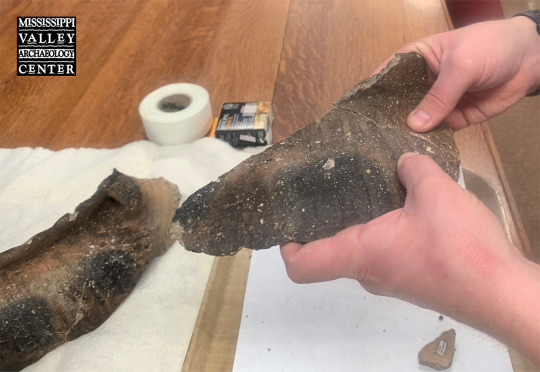
Thanks to Wendy Holtz-Leith and Erik Anderson for this week’s post –
In 2012 MVAC excavated about 500 Oneota features exposed during the reconstruction of STH 35/2nd Avenue in downtown Onalaska. One unusual discovery was a nearly complete vessel found crushed in place at the base of a feature. Vessel 45, as it was later numbered, was represented by well over a hundred fragments of varying sizes.
Reconstructing a vessel is much like putting together a three-dimensional jigsaw puzzle, with quite a few pieces missing. You typically begin with the edges, which in the case of pottery, means the rim. Rim fragments from Vessel 45 were reassembled, and decorated body pieces were glued together and attached to the rim. Then came the slow process of figuring out where the undecorated pieces went. Some parts of the vessel were easier to figure out. Sherds from the base were thicker and in some cases larger, making it easier to fit them into place.
After most of the pieces were glued into larger sections, it was time to glue those sections together to form the whole vessel. This task was complicated by three things. First, some small joining fragments were missing. Second, errors in forming a vessel’s curved shape tend to creep in during the gluing and drying. Right after gluing, refitted pieces are usually placed in a sandbox to dry, and any shift can alter the curvature, making subsequent joins difficult. Third, the exterior had scorch marks or firing smudges that made its color quite variable—sometimes even adjacent sherds were completely different colors. In the end the vessel was fully reconstructed (albeit precariously), but it was left in a few very large segments because of those subtle errors from gluing.
The reconstructed vessel is very large and slightly oblong. It has a moderately high, slightly everted (outward-flaring) rim with bold finger impressions on the lip top to exterior lip. There are two handles on opposite sides of the vessel. The shoulder decoration consists of alternating panels of 12 or 13 vertical trails made with either a finger or a broad tool, and four nested chevrons with rectangular punctations below. There are four panels of nested chevrons, one under each handle and the others midway between them. The oblong rim has a diameter of 36.5 cm (14.4 inches) at the handles and ~34 cm (13.4 inches) midway between the handles. The motif is typical of the type Perrot Punctate, with very bold lip-top impressions typical of the Pammel Creek phase, A.D. 1400–1500.
#archaeology#archeology#Oneota pottery#pottery#Oneota ceramics#ceramics#Wendy Holtz-Leith#Erik Anderson#Pottery Reconstruction#Ceramic Reconstruction
17 notes
·
View notes
Photo


Antler were being used by the Oneota as raw material for tools. This piece has had the tips of the tines removed to make into arrowpoints. Antler projectile points are one example of expertly crafted tools made from animal remains. The points typically have a smoothed outer surface and a hollowed-out socket at the base for affixing them to a shaft. Deer and elk antlers used to make the points would have come from animals hunted for food, and from naturally shed antlers. The antler pictured was recovered at the Pammel Creek site (located south of La Crosse, Wisconsin) and the antler tine projectile points were found at Oneota sites in the La Crosse area.
Link to 3D image: https://sketchfab.com/3d-models/bone-projectile-point-16bbe7c9627e4eb5b83802a357da7973
3D scan courtesy Dr. David A. Anderson, Associate Professor, UWL, Department of Archaeology & Anthropology.
Link to Dr. Jim Theler’s video on Bone Tools: https://www.youtube.com/watch?v=r28LznKH4J0
3 notes
·
View notes
Photo
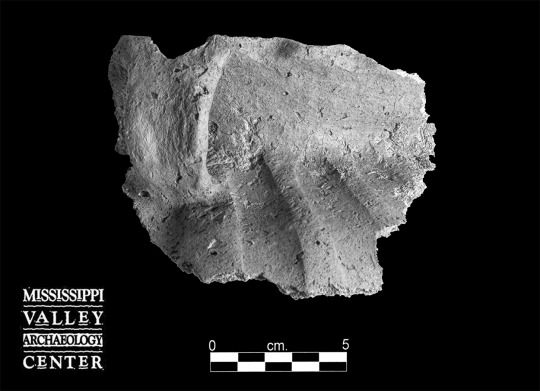
This Koshkonong Bold rim sherd was recovered from an Oneota circular basin, storage/garbage pit. It has lip top to exterior finger (wide) notches, giving the rim a pie-crust appearance. The vessel has a wide strap handle that tapers toward the bottom. The handle is attached below the lip and has no decoration. This rim dates to the Pammel Creek phase occupation of the site. Recovered during 2008 excavations at the Sand Lake Archaeological District, located north of La Crosse, Wisconsin.
#archaeology#archeology#Oneota#Koshkonong#$Pottery#Ceramics#Oneota pottery#Oneota ceramics#Sand Lake Archaeological District
8 notes
·
View notes
Photo

Thanks to Jim Theler for this week’s post –
Throwback Thursday - Shown here is Robert "Ernie" Boszhardt at the Meier Farm (47LC432) excavation in 2002. He is holding a pottery vessel rim with a handle attached. This sherd is assigned to the pottery type "Midway incised variety bold" of the Pammel Creek phase (AD 1400–1500) of the local Oneota occupation.
5 notes
·
View notes
Photo

Vessel 29 was found at the base of an ash lens in an oval storage or refuse pit. This Koshkonong Bold variety bold vessel portion has a distinctive handle attached at the lip. The handle is a loop, flattened on both sides, with bold finger impressions that give it a wavy appearance. The finger impressions on the lip are also bold, as are the vertical finger trails on the shoulder. Vessel 29 was recovered during excavations in the early 2000s at the Sanford Archaeological District in La Crosse, Wisconsin. It probably dates to the Pammel Creek phase (A.D. 1400-1500) of the local Oneota occupation.
4 notes
·
View notes
Photo
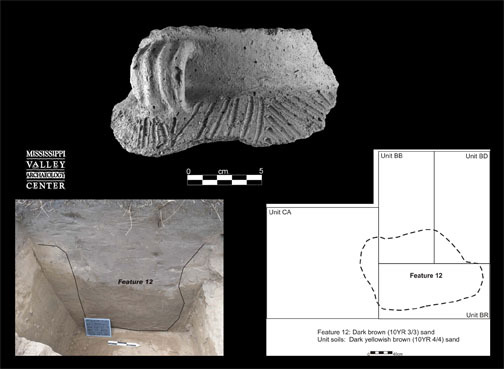
Feature 12 was an oval, basin-shaped Oneota storage/garbage pit 220 cm long, 140 cm wide, and 120 cm deep (87 by 55 by 47 inches). Despite its large size, the feature had relatively few artifacts, and they were scattered throughout the fill. No zones were noted in the profile walls. Three shell-tempered rims were found.
The pictured rim sherd is from a vessel with probable finger notching on the lip top and a Midway Incised motif on the shoulder. The lip notches are narrow for finger notches (only 7.0 to 9.2 mm, about ¼ inch), but they appear to have been made with a small finger-- not with a tool, like the pottery of the Valley View phase. A wide strap handle is attached below the rim. This rim/handle/shoulder combination is characteristic of the Pammel Creek phase and dates from about A.D. 1400 to 1500.
Pictured: Midway Incised rim sherd, feature profile, feature plan view. 2008 excavations at the Sand Lake Archaeological District, located north of La Crosse, Wisconsin.
28 notes
·
View notes
Photo

This feature was excavated in 2008 at the Sand Lake Archaeological District, located north of La Crosse, Wisconsin. It contained most if not all of a Koshkonong Bold variety bold exterior lip notched vessel. The sherds from this vessel were found in a tight cluster of stacked predominately large pieces. The vessel dates to the Pammel Creek phase (AD 1400-1500) based on the bold/finger notches and the placement of these decorations on the exterior of the rim. This vessel is unusual in that between the vertical finger trails are what looks to be thumb print impressions at the same level as the top of the finger trails.
#archaeology#archeology#Oneota pottery#Oneota#pottery#Koshkonong Bold#Sand Lake Archaeological District
9 notes
·
View notes
Text
<b>Sewage</b> pipe break on Mormon Coulee Road repaired
The break caused raw sewage to run into a storm drain and discharge out into Pammel Creek which empties into the Mississippi River. However, the ...
from Google Alert - sewage https://www.google.com/url?rct=j&sa=t&url=https://www.news8000.com/news/sewage-pipe-break-on-mormon-coulee-road-repaired/1059565882&ct=ga&cd=CAIyGmU0OWEzNWRjZTA0MTI3ZTg6Y29tOmVuOlVT&usg=AFQjCNH8P4HUhF7s-7R-c2E_G_3wNL222g
0 notes
Photo

In one feature at the Pammel Creek site, dumped into a layer only 10 cm thick, we found bone and antler, the tools for working them, the “blanks” or roughed out items, and finished pieces. This is a very dense concentration of materials used in the process of working bone and antler. We can suggest that Feature 139 contains the debris from a specialized workshop for making bone and antler tools.
No other feature at the site contained this much worked antler. In other features, there were few fragments of the raw antler from which the ornaments were produced. We can speculate that the manufacture of these items may have been conducted by one individual or household because so much of the debris is concentrated in one feature.
The context of this material was critical to its understanding. Without knowing where this material came from, it’s just fragments of cut bone.
The Pammel Creek site is located south of La Crosse, Wisconsin.
15 notes
·
View notes